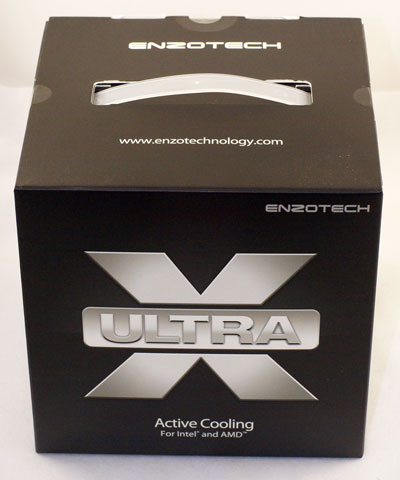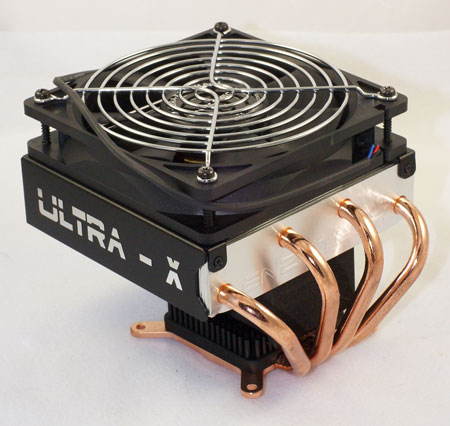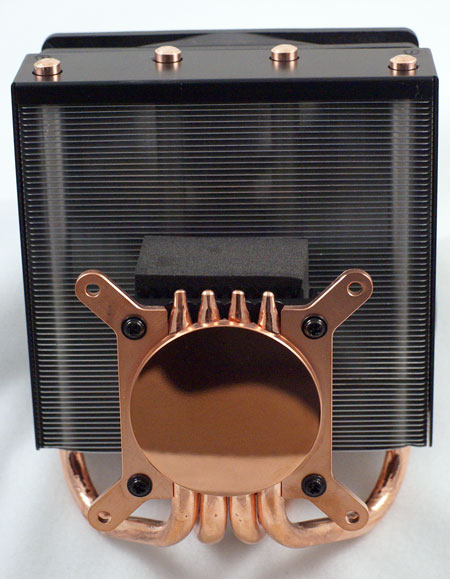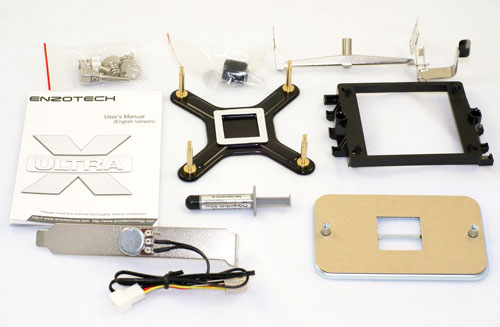Enzotech Ultra-X: If Looks Could Chill
by Wesley Fink on June 27, 2007 3:00 AM EST- Posted in
- Cases/Cooling/PSUs
Enzotech Ultra-X
The Ultra-X comes in a matte black and silver package with a side window that highlights the heatpipe cantilever.

All the information you need to make a buying decision is on the box - specifications, included accessories, CPU compatibility, etc. The only thing missing is a quick trip to AnandTech to check out how the cooler compares to others in cooling efficiency. Inside the package is a clear plastic molded clamshell that protects the individual components.

The cooler is designed around a high output down-facing fan blowing across a large cantilever of horizontal heatpipes cooled by vertical aluminum fins. The fin array is enclosed on all sides. Heatpipes extend from a base that is also cooled by another small heatsink to the heatpipe cantilever

Enzotech prominently features the mirror-finished copper base in all their literature. They claim the base is machined to 0.0003 per inch run out, "which optimizes surface contact and maximizes thermal conductivity performance". The mirror finish is certainly an excellent execution of machining. Our performance tests will better indicate whether it really makes any difference in performance.

The Ultra-X fan is a stock Delta fan controlled by a variable speed rheostat that can mount in an available card slot. This allows control of the fan speed even if the case is closed. Many of us remember Delta fans from AMD socket A days where the Delta delivered incredible air output at the price of extreme noise. This Delta claims output as high as 82.7 CFM at a less than quiet 38.5dbA. We will be measuring noise performance and reporting it compared to other tested coolers on p. 7.

Accessories include a mounting base and spring loaded screws for Intel socket 775 and a complete base, cage and clip for AMD sockets. Mounting of either Intel or AMD processors is very simple. Also included is a small syringe of premium Arctic Silver 5, and very clear installation instructions. Mounting is simple and very secure with either 775 or AMD. However, you will have to remove the motherboard to install the cooler - at least on Intel 775. While the motherboard is removed to place the base through the 4-holes in the 775 motherboard, go ahead and mount the spring screws. It can be really difficult to try to tighten these after the board is remounted.
Should you require further help with the installation process, Enzotech provides very clear installation videos for both Intel and AMD in the Ultra-X section of their website. While the Ultra-X is a very heavy cooler at 835g it is good to see strong and effective installation options available with the cooler. Ultra-X was very secure on both 775 and AMD sockets, providing peace of mind when mounting this heavy cooler on an expensive motherboard.
The Enzotech Ultra X is one of the more expensive coolers we have tested. Web prices ranged from $63 to $65. Enzotech distributes their products through specialty cooling shops, so you will not find them at volume resellers. Our sincere thanks go to Frozen CPU for arranging a retail review sample of the Ultra-X. We would not have been able to turn a review around so quickly without their help.
Specifications
Our test system is Intel socket 775, but the Ultra-X will also mount on any recent AMD socket as well - including 754/939/940 and AM2. The Enzotech kit includes the back plate, cage, and mounting clip for AMD processors. All the needed hardware is included, and installation is even easier than the 775 install - particularly on a mounted motherboard.
The Ultra-X is relatively large, but it is shorter in height than most of the heatpipe tower coolers. The heatpipe cantilever overhangs the base, so you can also cool a Northbridge or hot power transistors depending on how you mount the cooler. Enzotech did not provide recommended orientations for the cooler for various case designs.
The EVGA 680i is a difficult to fit board due to the copper-finned heatsink and fan cooling the Northbridge. The Enzotech fit comfortably but clearances required mounting the cooler out of the case before mounting the motherboard in the case. Installation was also an easy task on the ASUS Striker and ASUS Commando, and on the two new ASUS P35 boards - the P5K Deluxe and P5K3 Deluxe. The P5K3 Deluxe will likely become a fit test for any motherboard, since the heatpipes completely circle the CPU socket and connect various cooling heatsinks around the CPU socket.
The Ultra-X comes in a matte black and silver package with a side window that highlights the heatpipe cantilever.

All the information you need to make a buying decision is on the box - specifications, included accessories, CPU compatibility, etc. The only thing missing is a quick trip to AnandTech to check out how the cooler compares to others in cooling efficiency. Inside the package is a clear plastic molded clamshell that protects the individual components.

The cooler is designed around a high output down-facing fan blowing across a large cantilever of horizontal heatpipes cooled by vertical aluminum fins. The fin array is enclosed on all sides. Heatpipes extend from a base that is also cooled by another small heatsink to the heatpipe cantilever

Enzotech prominently features the mirror-finished copper base in all their literature. They claim the base is machined to 0.0003 per inch run out, "which optimizes surface contact and maximizes thermal conductivity performance". The mirror finish is certainly an excellent execution of machining. Our performance tests will better indicate whether it really makes any difference in performance.

The Ultra-X fan is a stock Delta fan controlled by a variable speed rheostat that can mount in an available card slot. This allows control of the fan speed even if the case is closed. Many of us remember Delta fans from AMD socket A days where the Delta delivered incredible air output at the price of extreme noise. This Delta claims output as high as 82.7 CFM at a less than quiet 38.5dbA. We will be measuring noise performance and reporting it compared to other tested coolers on p. 7.

Accessories include a mounting base and spring loaded screws for Intel socket 775 and a complete base, cage and clip for AMD sockets. Mounting of either Intel or AMD processors is very simple. Also included is a small syringe of premium Arctic Silver 5, and very clear installation instructions. Mounting is simple and very secure with either 775 or AMD. However, you will have to remove the motherboard to install the cooler - at least on Intel 775. While the motherboard is removed to place the base through the 4-holes in the 775 motherboard, go ahead and mount the spring screws. It can be really difficult to try to tighten these after the board is remounted.
Should you require further help with the installation process, Enzotech provides very clear installation videos for both Intel and AMD in the Ultra-X section of their website. While the Ultra-X is a very heavy cooler at 835g it is good to see strong and effective installation options available with the cooler. Ultra-X was very secure on both 775 and AMD sockets, providing peace of mind when mounting this heavy cooler on an expensive motherboard.
The Enzotech Ultra X is one of the more expensive coolers we have tested. Web prices ranged from $63 to $65. Enzotech distributes their products through specialty cooling shops, so you will not find them at volume resellers. Our sincere thanks go to Frozen CPU for arranging a retail review sample of the Ultra-X. We would not have been able to turn a review around so quickly without their help.
Specifications
Our test system is Intel socket 775, but the Ultra-X will also mount on any recent AMD socket as well - including 754/939/940 and AM2. The Enzotech kit includes the back plate, cage, and mounting clip for AMD processors. All the needed hardware is included, and installation is even easier than the 775 install - particularly on a mounted motherboard.
| Enzotech Ultra-X Specifications | ||||
| Heatsink | ||||
| Dimensions | 148(W) X 148(D) X 118(H)mm | |||
| Weight | 835g | |||
| Material | Mirror-Polished Copper Base and Aluminum Fins | |||
| Heatpipes | Four 8mm copper heatpipes | |||
| Fan | ||||
| Fan Size | 120 x120x 25mm | |||
| Bearing Type | 2-ball Delta AFB1212H-FOO | |||
| Connector | 3-pin with integral fan-speed rheostat | |||
| Speed | Lo Speed | 1,200rpm | Hi Speed | 2,500rpm |
| Noise Level | Lo Speed | 24.5dBA | Hi Speed | 38.5dBA |
| Fan Output | Lo Speed | 35.8cfm | Hi Speed | 82.67cfm |
The Ultra-X is relatively large, but it is shorter in height than most of the heatpipe tower coolers. The heatpipe cantilever overhangs the base, so you can also cool a Northbridge or hot power transistors depending on how you mount the cooler. Enzotech did not provide recommended orientations for the cooler for various case designs.
The EVGA 680i is a difficult to fit board due to the copper-finned heatsink and fan cooling the Northbridge. The Enzotech fit comfortably but clearances required mounting the cooler out of the case before mounting the motherboard in the case. Installation was also an easy task on the ASUS Striker and ASUS Commando, and on the two new ASUS P35 boards - the P5K Deluxe and P5K3 Deluxe. The P5K3 Deluxe will likely become a fit test for any motherboard, since the heatpipes completely circle the CPU socket and connect various cooling heatsinks around the CPU socket.










33 Comments
View All Comments
Spanki - Thursday, June 28, 2007 - link
Since I've been pushing to see this sink reviewed at AT, I'd like to be sure to thank you for doing it - thanks!I guess I still have on-going concerns about your test setup and conclusions drawn based on that setup - ie. if you had a side-vent/fan, and also used exhaust fans, your conclusions might be wildly different (as the results we're all seeing in other reviews). Maybe it's the Tower coolers that suffer in those conditions (? I dunno... but your results just don't jibe with other results, where a side-vent might be in use).
I'm not suggesting that everyone should go buy a case with a side vent, only that those who DO own a case with a side-vent/fan might be getting the wrong impression from your general conclusions about top-blowers.
My only other quibble is your comments on price, but I guess if the place who loaned the HSF sells it for X then that must be the "lowest price" you found (~$63)... I've listed at least 4 sites in the forums that sell it for under $60 (ok, $59.99 :) ).
Anyway, nice job as usual - thanks.
Wesley Fink - Thursday, June 28, 2007 - link
The side vent or hole is to bring air IN, not to exhaust air. The fan on these coolers blows down onto the heatpipe cantilever and CPU block. Readers have been suggesting that an added case exhaust fan at the rear would correct the down-facing cooler performance. As stated in the review we tried an added 120mm rear exhaust fan to our setup and it did improve cooling, but did not improve overclocking.We also ran tests with the side cover off the case above the cooler. Certainly an entire open side will allow as much cooling air to enter the case as a side vent (the test case also has low front vents for air entry, as most cases do). The results with the open side were no different than we show in the review.
Spanki - Thursday, June 28, 2007 - link
Yes, obviously I was referring to the side vent/fan bringing air IN :). Consider the following though (bare with me)...For purposes of example, let's say that user A uses an http://www.antec.com/us/productDetails.php?ProdID=...">Antec 900 case (with a 120mm fan attached to the side vent) and user B uses an http://www.antec.com/us/productDetails.php?ProdID=...">Antec P182 case. And both users are trying to decide between getting the TR Ultra 120 Extreme or Enzo Ultra-X (again, just for example purposes).
TR Ultra 120:
Height = 160.5mm
Weight = 790g + http://www.madshrimps.be/?action=getarticle&ar...">164g for Scythe S-FLEX SFF21F fan = 954g
Price = http://www.frozencpu.com/products/5664/cpu-tri-39/...">$64.95 + http://www.frozencpu.com/products/2506/fan-206/Scy...">$14.99 = $79.84 (I won't include the price of the lapping kit, since many people won't bother)
Enzo Ultra-X:
Height = 118mm + 25mm for fan = 143mm
Weight = 835g
Price = http://www.frozencpu.com/products/5516/cpu-enz-01/...">$62.99 (no lapping needed)
...I don't have an Antec 900 case to know for sure, but again for the purpose of example, let's assume that the extra height of the Ultra 120 Extreme means that user A has to remove the fan from his side vent, but not with the Enzo Ultra-X.
From your testing, it seems relatively apparent that user B (no side vent) will get the best cooling performance with the TR Ultra 120 Extreme.
But is it 'concievable' to you that user A could possibly get better cooling performance with an Enzo Ultra-X (side vent, with fan, blowing down into the top of it)?
Personally, I don't know the answer and I'm not trying to champion top-blower design heatsinks either - what I'm trying to do is reconcile the fact that your reviews are not consistent with many other reviews (both from sites and end-users), in the case of top-blower heatsinks.
Obviously there are many many factors that come into play from one review/user configuration to the next (cpu used, "load" app, fan speed, mounting pressure, TIM application, etc), but that's not accounting for the relative differences between heatsinks tested on the same configuration.
Doesn't that bother you? Or are you pretty comfortable with the idea that all the other reviews are just getting it wrong?
magreen1 - Thursday, June 28, 2007 - link
Yes, and what if my mother likes the Enzo Ultra-X cooler but has a grudge against the TR Ultra Extreme cooler. So if I buy the TR cooler she'll take away my allowance for three weeks. Then I'll have to get a cheaper CPU to save money... maybe an E4300 instead of an E6600, with 2MB less cache. So maybe we should compare performance of the Enzo Ultra-X with an e6600 overclocked to the TR Ultra Extreme with an e4300 overclocked... just to be fair.Spanki - Thursday, June 28, 2007 - link
Heh. So you're suggesting that I'm nit-picking? Or have some bias towards the Enzo or away from the TR?Let me re-state my motives, just to be clear...
- I don't own an Ezno and have no stake what-so-ever in whether it rox or sux.
- Same is true with TR products.
- I have zero love/brand-loyalty or even hate/beef with any particular company's product.
- I actually have a CM Hyper Tx cooler on my personal system, because it serves my particular needs perfectly.
- I'd like for other readers/users to have the most complete information available to them, so they can figure out the best cooler for thier particular needs.
...in short, the issue to me is acedemic at this point. And if there weren't many conflicting reports out there, I might even drink the Kool-Aid and take the "side-blowers out-perform top-blowers" opinion at face value.
The problem (as I see it) is that there are conflicting results out there and so there is some reason for those differences. I am interested to know what those reasons are. I'm assuming that Wesley (and his readers) is likely at least curious as well. Seems like you would be too... are do you just choose to believe one internet stranger over another?
(The above is no slam on Wesley btw... I happen to think he's a smart, skilled, professional reviewer - which is what leads me to believe that he'd be curious about this apparent discrepency).
strikeback03 - Friday, June 29, 2007 - link
I'd guess that to really solve the question of this variation, the same reviewer would have to test the same group of coolers in different ways. an AMD system, a C2D system, an old P4 system, etc. IIRC some sites don't test on a processor at all, but a heated block. Cases and airflow have a role to play, and some coolers might respond better than others to those changes. so for a site that keeps a consistent method, results are probably correct for that setup, but tests witht he same coolers across a range would be needed to isolate why some places give better reports than others.As far as user opinions, they are at best only somewhat useful. I can tell you that according to the Foxconn software that came with my board, my Tuniq holds my E6600 at 1-2 degrees over ambient at idle. Whight I might not mention is that before a BIOS update the Foxconn software was reporting that the processor was cooler than ambient, and also disagreed with the temp reading in the BIOS. So no guarantees the current figure is correct either.
Spanki - Thursday, June 28, 2007 - link
Whoops.. I started out doing the comparison with the Ultra 120 (non-extreme) but then decided to use the Extreme (so there's a typo in the labeling, above). Anyway, since this is hypothetical anyway, I'd be just as comfortable with posing the same question comparing the non-extreme version, but you'd have to use the non-extreme weight and price figures, bringing the two sinks much closer together in those aspects.DrMrLordX - Thursday, June 28, 2007 - link
Actually, I think he specifically meant side vents or side fans for intake . . . which is what I was asking about above.Does your test bed have a side intake vent/duct/etc?
DrMrLordX - Thursday, June 28, 2007 - link
woops, missed the part in your comment where you said you tested with the side of the case off. Disregard please.jmke - Thursday, June 28, 2007 - link
It's Thermaltake who makes Big Typhoon VX, not Coolermaster (last paragraph 1st page;))